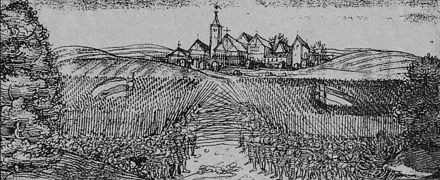Battle of Bergtheim
The battle of Bergtheim took place on January 11, 1400 (according to other sources on January 4, 1400) between troops of the Prince-Bishop of Würzburg , Gerhard von Schwarzburg , and an army of rebellious citizens and farmers from Würzburg and other cities at the gates of Bergtheim .
Development of the conflict
Between July 1396 and 1399, Würzburg joined forces with the cities of the Würzburg Monastery to form the Eleven Cities League . These were Arnstein , Bischofsheim an der Rhön , Ebern , Fladungen , Gerolzhofen , Haßfurt , Iphofen , Karlstadt , Königshofen im Grabfeld , Meiningen , Mellrichstadt , Neustadt an der Saale , Seßlach and Stadtschwarzach . The federal government strove for imperial immediacy , since the taxation by the highly indebted Hochstift was felt to be unjust. King Wenceslas placed these eleven cities under his protection in October 1397; at the same time they were put on an equal footing with the other imperial cities . In Würzburg, out of enthusiasm for the royal protection, the imperial eagle was struck on the city gates and a gold-plated pair of coats of arms was placed on the gable of the town hall. However, the old rights of the bishop were confirmed by Wenceslaus, and just two years later the king asked the cities to pay homage to the bishop. The tensions led to the bishop banning the city, whereupon the citizens of Würzburg captured three clergymen from the Schwarzburg family. Bishop Gerhard von Schwarzburg was able to save himself to the Marienberg Fortress , where he was greeted by his brother Günther XXVII two weeks later. was released. Von Schwarzburg had also started building a fortress to keep the citizens down. However, this was destroyed in the beginning by the Würzburgers.
Battle of Bergtheim
When the tensions led to war, the towns of Meiningen and Ebern submitted to the request of the royal deputy Bořivoj von Svinař in 1399, while Haßfurt was able to defend itself for seven weeks. Würzburg was cut off from supplies by the episcopal troops, which were supported by the Counts of Schwarzburg , the Counts of Henneberg , the Burgraves of Nuremberg and the troops of Duke Ludwig of Bavaria , so that the besieged suffered hunger. Contrary to the warnings of the council, the guilds decided to venture out to Bergtheim, a four-hour walk away, as the churchyard there was fortified with the grain stores of the cathedral chapter. The failure of the allegedly 3,000-strong civil army then took place on the night of January 11, 1400 (according to other sources, on the night of January 4, 1400).
Bishop Gerhard von Schwarzburg was sick in the Wasserburg Werneck ; through betrayal, however, he learned of the project and had the Bergtheim churchyard occupied. In addition, under the command of Dompropst Johann I von Egloffstein and the knight Wilhelm Geyer von Giebelstadt, he sent out the contingent of his pen nobility, 650 armed riders.
After the battle order of the rebels was already in the process of disintegrating after two hours of fighting in the pursuit of the bishops, a troop of 62 knights and servants from the Haßberg mountains arrived on the battlefield. With this reinforcement, the bishop's troops regrouped. They voted the crusader song In God's name we drove up and took up the fight again, with most of the riders dismounted and fought on foot. The battle ended in defeat for the insurgents, of whom about 1,100 were killed and about 400 were captured.
Consequences of the battle
The leaders of the rebels were beheaded or drowned in the Main. Four patricians of the council were quartered and hung on the city gates of Würzburg as a deterrent. These were Hans Weibler, Jakob vom Löwen, Seifried vom Rebstock and Hans von Erfurt. Since the patriciate fled and many wealthy citizens also left the city, Würzburg suffered severe economic damage as a result. For example, 2,600 taxable citizens were registered in 1398, compared to only 1,400 a few years after the Battle of Bergtheim. Financial reparations also needed to be made.
Literary processing
Bernhard von Uissigheim fought as a member of the local nobility of Uissigheim on the side of the episcopal armed forces. His literary processing of the battle led to the most extensive political poetry of events of the late Middle Ages and the early modern period . His poem with around 2,200 verses portrays the rebels in a ridiculous manner and makes them appear traitors, while the Frankish nobility is positively emphasized. The seal also reacts to mock seals on the opposite side. In 1525 it was printed on behalf of the authorities; previously it was only available in handwriting. The following excerpts describe the exodus of the rebels under their captain Kunz turnip:
- Some of you were well armed /
- his bladder was also full of wine
- his shield was a basket of manure,
- so that he may live away his wife and children,
- a coarse felt his monkshood
- Breastplate and his harness cap /
- and his basin hood slump /
- that was a pan with Haberbrei
literature
- Klaus Arnold: Spotlight: The Battle of Bergtheim 1400 . In: Ulrich Wagner (Ed.): History of the City of Würzburg, Volume I, Verlag Theiss, Stuttgart 2001, pp. 110-113, ISBN 3-8062-1465-4
- Carlheinz Gräter: At Bergtheim the freedom of the city went under . In: Fränkische Nachrichten of January 11, 2000
Web links
- Battle of Bergtheim . In: wuerzburgwiki.de
- Sonja Kerth: Bernhard von Uissigheim: From the Würzburg city war . In: Historisches Lexikon Bayerns from May 6, 2010, accessed on June 3, 2011
